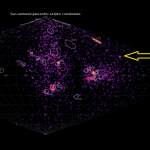By Denis Vida and Peter Eschman
Global Meteor Network stations in New Mexico recorded three Camelopardalid (CAM#451) orbits during the predicted 2019 outburst. Here we present the details of observations and give the parameters of estimated orbits.
1 Introduction
The young Camelopardalid meteor shower, produced by the comet 209P/LINEAR, had an outburst in 2019. The main peak was predicted around 7h44m UT on 24 May at a very high declination geocentric radiant of RA=123.2°, Dec=+79.9°. The timing of the outburst favored observers in the western part of North America, Pacific, and Eastern Asia. A trail ejected in 1939 was predicted to cause this outburst of low activity (ZHR around 10). The modelling and prediction were done by Mikhail Maslov [1].
The Global Meteor Network (GMN) [2] is a world-wide network of low-cost meteor stations running open-source software on Raspberry Pi single-board computers. See Vida et al. (2019) for more details.
Three Camelopardalids were recorded by GMN stations in New Mexico (Figures 2, 6 and 7). Five different stations recorded these meteors, and observations were manually reduced using the tools in the RMS library [3] to ensure measurement quality, and the trajectories were computed using the Monte Carlo method of Vida et al. (2019).
2 Results
The three Camelopardalids were recorded in a ~4 hour window, from 04h45m to 09h00m UTC on May 24. Figure 1 shows their orbits, and Table 1 lists their orbital elements. We note that all observations were within ~1 degree of the predicted radiant at RA=123.2°, Dec=+79.9°, possibly indicating a tight radiant dispersion. Nevertheless, no concrete conclusions about the dispersion can be made due to small number statistics. Our observations also agree well with values reported by other observers for the much larger 2014 outburst.

Figure 1 – Heliocentric orbits of the three recorded Camelopardalids (top view).
Table 1 – The radiant and orbit data compared to recent values from literature. Note that the reported uncertainties estimate the measurement precision, not the absolute accuracy.
| Orbit | λʘ (°) | αg (°) | δg (°) | vg (km/s) | a (AU) | q (AU) | e | ω (°) | Ω (°) | i (°) | Π (°) |
| 20190524_044439 | 62.49 | 116.9 ±0.8 |
+79.7 ±0.1 |
15.63 ±0.05 |
2.57 ±0.03 |
0.9640 ±0.0005 |
0.625 ±0.004 |
151.1 ±0.2 |
62.5 | 20.88 ±0.06 |
213.57 ±0.19 |
| 20190524_072227 | 62.60 | 125.4 ±2.0 |
+79.6 ±0.4 |
14.91 ±0.06 |
2.41 ±0.03 |
0.9702 ±0.0011 |
0.598 ±0.005 |
152.6 ±0.4 |
62.6 | 20.10 ±0.17 |
215.22 ±0.40 |
| 20190524_085835 | 62.66 | 120.4 ±1.3 |
+78.9 ±0.2 |
15.61 ±0.03 |
2.68 ±0.04 |
0.9657 ±0.0009 |
0.639 ±0.004 |
151.8 ±0.3 |
62.7 | 20.61 ±0.07 |
214.46 ±0.31 |
| 2014 Jenniskens et al. (2018) | 62.8 | 120.0 | +78.7 | 15.3 | 2.59 | 0.966 | 0.627 | 151.5 | 62.8 | 20.2 | |
| Annual Jenniskens et al. (2018) | 62.9 | 119.7 | +79.8 | 15.6 | 2.58 | 0.965 | 0.626 | 151.4 | 62.9 | 20.9 |
Figure 2 – The Camelopardalid recorded at GMN station US000L on 2019-05-24 04h44m39.04s UTC.
To give the readers some insight into the data, we give several plots. Figure 3 shows the lag (the distance that the meteoroid falls behind an object with a constant velocity that is equal to the initial meteoroid velocity) of the first observed meteor. As it can be seen, the meteor shows obvious deceleration. Figure 4 shows the ground track and the four stations that observed the second meteor, and Figure 5 shows the spatial fit residuals for the third meteor. The average angular fit residuals for all meteors were on the order of 1 arc minute.

Figure 3 – Lag of the Camelopardalid recorded on 2019-05-24 04h44m39.04s UTC.

Figure 4 – Lag of the Camelopardalid recorded on 2019-05-24 04h44m39.04s UTC.

Figure 5 – Spatial residuals for the Camelopardalid 2019-05-24 08h58m35.90s UTC.
Figure 6 – The Camelopardalid recorded at GMN station US0007 on 2019-05-24 08h58m35.90s UTC.
This is a very encouraging result for the Global Meteor Network and confirmation of the main objectives that were set when the RMS project was started:
- We recorded unique outbursts.
- The data was collected and reduced in a matter of days.
- The results are consistent with models and previous work.
Figure 7 – The Camelopardalid recorded at GMN station US0004 on 2019-05-24 07h22m27.40s UTC.
Acknowledgments
We would like to thank the folks operating the New Mexico Meteor Array for their hard work and dedication, and Paul Roggemans for editing this article.
References
Jenniskens P., Baggaley J., Crumpton I., Aldous P., Pokorny P., Janches D., Gural P. S., Samuels D., Albers J., Howell A., Johannink C., Breukers M., Odeh M., Moskovitz N., Collison J. and Ganjuag S. (2018). “A survey of southern hemisphere meteor showers”. Planetary Space Science, 154, 21–29.
Vida D., Šegon D., Merlak A. (2019). “The overview of the Global Meteor Network project and preliminary results of the 2018 Geminids”. eMetN, 4, 22–24.
Vida D, Gural P., Brown P. G., Campbell-Brown M., Wiegert P. (2019). “Estimating trajectories of meteors: an observational Monte Carlo approach–I. Theory”. Monthly Notices of the Royal Astronomical Society, 491(2), 2688–2705.
[1] Mikhail Maslov’s predictions : http://feraj.ru/Radiants/Predictions/209p-ids2019eng.html
[2] Global Meteor Network: https://globalmeteornetwork.org/
[3] RMS library on GitHub: https://github.com/CroatianMeteorNetwork/RMS
Figure 8 – The Camelopardalid recorded at GMN station US0002 on 2019-05-24 04h44m39.04s UTC.
Figure 9 – The Camelopardalid recorded at GMN station US0004 on 2019-05-24 04h44m39.04s UTC.
Figure 10 – The Camelopardalid recorded at GMN station US0002 on 2019-05-24 07h22m27.40s UTC.
Figure 11 – The Camelopardalid recorded at GMN station US000L on 2019-05-24 07h22m27.40s UTC.
Figure 12 – The Camelopardalid recorded at GMN station US0004 on 2019-05-24 08h58m35.90s UTC.


